Monthly Archives: November 2018
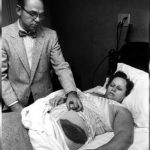 When most people think of a meteor or meteorite hitting the earth, they think of the complete destruction of our planet, because that is the image portrayed by the movies, but the reality is that the earth gets hit quite a bit, and the effects are far from disastrous. What is far more unusual, and in reality, almost non existent, is the probability of a person getting hit by a meteorite, in fact, there may only be one known case of that at all.
When most people think of a meteor or meteorite hitting the earth, they think of the complete destruction of our planet, because that is the image portrayed by the movies, but the reality is that the earth gets hit quite a bit, and the effects are far from disastrous. What is far more unusual, and in reality, almost non existent, is the probability of a person getting hit by a meteorite, in fact, there may only be one known case of that at all.
The Sylacauga meteorite fell on November 30, 1954, at 12:46 local time in Oak Grove, Alabama, near Sylacauga. It is commonly called the Hodges meteorite because a fragment of it struck Ann Elizabeth Fowler Hodges (1920–1972). It is thought that Hodges is the only person ever hit by a meteorite, and the meteorite, while officially named the Sylacauga meteorite, was nicknamed the Hodges meteorite. As the meteorite made its way to Earth, the 8 1/2 pound grapefruit-sized chunk of space rock crashed through the roof of Hodges’ home, hit large wooden console radio, and ricocheted into her side and hand, while she napped on a couch. It left a nasty bruise, which looks eerily like a meteorite itself. It was the first documented extraterrestrial object to have injured a human being. The 34-year-old woman was badly bruised on one side of her body, but was able to walk. The event received worldwide publicity.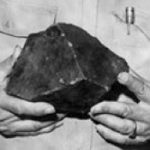
The meteor made a fireball visible from three states as it streaked through the atmosphere, even though it fell early in the afternoon. There were also indications of an air blast, as witnesses described hearing “explosions or loud booms”. The meteorite was confiscated by the Sylacauga police chief who then turned it over to the United States Air Force. Both Hodges and her landlord, Bertie Guy, claimed the rock, Guy’s claim being that it had fallen on her property. There were offers of up to $5,000 for the meteorite. Hodges and Bertie Guy settled, with Hodges paying $500 for the rock. However, by the time it was returned to Hodges, over a year later, public attention had diminished, and they were unable to then find a buyer. Ann Hodges was uncomfortable with the public attention and the stress of the dispute over ownership of the meteorite, so she donated it to the Alabama Museum of Natural History in 1956. The day after the fall, local farmer Julius McKinney came upon the second-largest fragment from the same meteorite. An Indianapolis-based lawyer purchased it for the Smithsonian Institution. The McKinney family was able to use the money to purchase a car and a house.
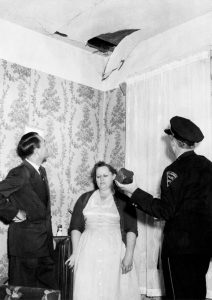
Upon the entry into the atmosphere, the Sylacauga meteorite fragmented into at least 3 pieces…the Hodges fragment 8.5 pounds that struck Ann Elizabeth Hodges. The McKinney fragment 3.7 pounds was found the next day December 1, 1954 by Julius Kempis McKinney, an African-American farmer who sold the meteorite fragment he found to purchase a car and a house. A third fragment is believed to have impacted somewhere near Childersburg northwest of Oak Grove. The meteoroid came in on the sunward side of the Earth, so when it hit, it had passed the perihelion and was traveling outward from the Sun. Considering the orbit estimations, the best candidate as parent body is 1685 Toro. The Sylacauga meteorite is classified as an ordinary chondrite of H4 group. I don’t suppose Ann Elizabeth Hodges cared what kind it was, just that it almost killed her.

 Nick Olsen became my grandnephew when he married my grandniece, Siara this past summer. Nick is perfect for Siara. They love to laugh, and they are always doing funny things. Nick loves to make people laugh, and he has a funny, sarcastic way to do just that. That is something I like. I find comedic sarcasm to be extremely fun, and I like when people are able to laugh at themselves. That describes Nick perfectly. He’s usually up for whatever goofy things Siara wants to do. I think his joking ways were probably in large part one of the things that attracted Siara to him in the first place.
Nick Olsen became my grandnephew when he married my grandniece, Siara this past summer. Nick is perfect for Siara. They love to laugh, and they are always doing funny things. Nick loves to make people laugh, and he has a funny, sarcastic way to do just that. That is something I like. I find comedic sarcasm to be extremely fun, and I like when people are able to laugh at themselves. That describes Nick perfectly. He’s usually up for whatever goofy things Siara wants to do. I think his joking ways were probably in large part one of the things that attracted Siara to him in the first place.
Nick is a hard working man, who takes good care of his wife, and will someday make a great dad, I’m sure. He came from a big family, with 6 siblings, and he loves his mom very much. I’m sure he will want to have his own family. Nick and Siara already have two fur babies, Forest and Emma…their cats. Siara tells me that Nick is obsessed with Emma, and she’s not too sure he doesn’t love the cat more than he does her, but I don’t think so. Nick can fix just about anything, and so he keeps things in their house in good repair. He also likes to “surprise” Siara with a very clean house when she gets home from work. Now that makes him a pretty rare sort of a guy, and a keeper for sure.
Nick and Siara’s dad, Dave Balcerzak have bonded quite well over sports, as well as everything else. They 
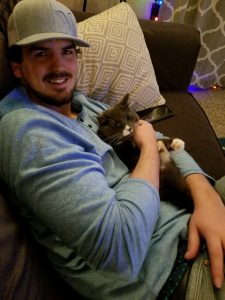 really enjoy getting together to watch the football games. Nick’s favorite team is the Seahawks, but Siara and Dave’s is the Steelers. I’m not sure how that works while watching the games, but they seem to be able to deal with their differences, and the games they spend time watching together are mutually fun for everyone…unless the two teams are playing against each other, that is…then it’s probably war!! Even if they were playing against each other, I’m sure that there would be some good natured ribbing, especially from the winner, but they would still be good friends, and that’s great, because Siara loves her daddy and her hubby, and she loves that they get along so well. Today is Nick’s birthday. Happy birthday Nick!! Have a great day!! We love you!!
really enjoy getting together to watch the football games. Nick’s favorite team is the Seahawks, but Siara and Dave’s is the Steelers. I’m not sure how that works while watching the games, but they seem to be able to deal with their differences, and the games they spend time watching together are mutually fun for everyone…unless the two teams are playing against each other, that is…then it’s probably war!! Even if they were playing against each other, I’m sure that there would be some good natured ribbing, especially from the winner, but they would still be good friends, and that’s great, because Siara loves her daddy and her hubby, and she loves that they get along so well. Today is Nick’s birthday. Happy birthday Nick!! Have a great day!! We love you!!
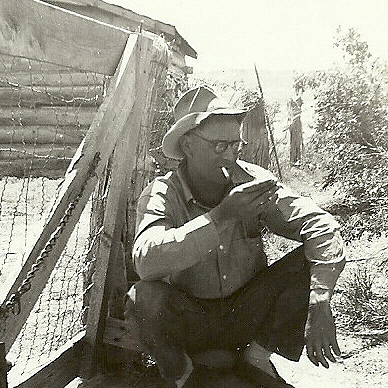 Last June while my husband, Bob and I were walking on the path near our home, we noticed a friend’s vegetable garden. Since it had gone from plowed dirt to medium sized plants, virtually over night, we knew that they had put in plants and not planted seeds. This conversation brought a memory to Bob, about his childhood years. The garden that they had on the land that his parents, Walt and Joann Schulenberg shared with his grandparents, Robert and Nettie Knox was quite large, and Bob remembers checking the garden almost daily to see if the seeds they had planted had begun to sprout. He and his grandpa would go out into the garden and young Bob would see something green in the places where the seeds had been planted. He would immediately ask, “Is that a plant Grandpa?” Only to be disappointed when his grandpa said, “No, that’s a weed.”
Last June while my husband, Bob and I were walking on the path near our home, we noticed a friend’s vegetable garden. Since it had gone from plowed dirt to medium sized plants, virtually over night, we knew that they had put in plants and not planted seeds. This conversation brought a memory to Bob, about his childhood years. The garden that they had on the land that his parents, Walt and Joann Schulenberg shared with his grandparents, Robert and Nettie Knox was quite large, and Bob remembers checking the garden almost daily to see if the seeds they had planted had begun to sprout. He and his grandpa would go out into the garden and young Bob would see something green in the places where the seeds had been planted. He would immediately ask, “Is that a plant Grandpa?” Only to be disappointed when his grandpa said, “No, that’s a weed.”
I was struck by the memory of my husband’s grandfather, who wasn’t really a social person most of the time, but when he was in the garden…well, he was really in his element. I could picture Grandpa and young Bob out in the garden, while he worked to educate his grandson on the finer points of gardening. Grandpa knew how to do many things, but it was in the garden that he really seemed at home. As a younger man, he worked on several ranches and so being in the outdoors, working with his hands makes sense. I don’t suppose that many men seriously enjoy gardening, and I don’t know if I can really picture Grandpa in a flower garden, but when it came to a vegetable garden, he took great pride in it and in the food it supplied to the family.
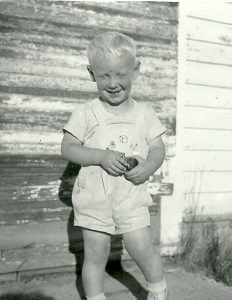
When the vegetables were ripe, he would pick them and the canning would commence. I remember, after I joined the family, the canning taking place. It took all day, but when we were done, there were vegetables to last for the year. I can’t say that canning was always one of my favorite things to do, but there was always a certain satisfaction that came from opening those vegetables to serve for dinner, and knowing where they came from. The nice thing about having Grandpa handling the garden was that truly, he did all the hard work, and we reaped the benefit. I say that because I am not really a green thumb, so gardening and especially weeding are not my idea of a pleasant afternoon. Nevertheless, that was most certainly Grandpa Knox’s idea of a pleasant afternoon, ad it was a very nice memory of him. Today would have been Grandpa’s 109th birthday. Happy birthday in Heaven Grandpa Knox. We love and miss you very much.

 Like most adults, my niece, Machelle Moore has struggled with her weight over the years. It’s a tough place to be, and one that many people can fully understand. Then she discovered Keto, which is a high fat, medium protein, low carbohydrate diet. Many people think it is a new or fad diet, but it really isn’t. Keto is the correct way to eat Carbohydrates, especially sugar are not necessary to our diets, and sugar rally isn’t good for us. The body works much better when it burns fat for fuel, and not carbs.
Like most adults, my niece, Machelle Moore has struggled with her weight over the years. It’s a tough place to be, and one that many people can fully understand. Then she discovered Keto, which is a high fat, medium protein, low carbohydrate diet. Many people think it is a new or fad diet, but it really isn’t. Keto is the correct way to eat Carbohydrates, especially sugar are not necessary to our diets, and sugar rally isn’t good for us. The body works much better when it burns fat for fuel, and not carbs.
Keto is unique diet, in that each person can adapt it to their own style and tastes. Machelle used protein shakes for breakfast and lunch, and limited her carbs. Machelle just went quietly along, not telling anyone what she was doing, and since she lives in Powell, Wyoming and most of the rest of the family lives in Casper, Wyoming, she was able to pull off an amazing transformation, while remaining almost hidden for view. As of August, she lost 60 pounds,and she looks absolutely stunning.
No diet is ever totally easy, but I think that Keto comes very close to that place. There is such a good variety of foods that work with it, and the necessary exercise can be fairly minimal. Machelle and her family love going camping and rock hunting, so hiking through the mountain is largely what she does. The nice thing about Keto  is that it works well with exercise. Your energy levels are well sustained, and you can go longer before needing the next meal. Machelle has worked hard and stayed with her plan, becoming more active as she went along, and now, she looks absolutely fabulous.
is that it works well with exercise. Your energy levels are well sustained, and you can go longer before needing the next meal. Machelle has worked hard and stayed with her plan, becoming more active as she went along, and now, she looks absolutely fabulous.
There is really nothing quite like taking back your life and feeling good about yourself again. She is able to hold her head up and be comfortable standing next to her husband again. Machelle’s husband, Steve has always been slender, so I know that it felt uncomfortable, because I have been there myself, and I know how it feels to stand next to your slim husband, when you are not. Now that Machelle is slim too, she and her husband can look forward to lots of great camping and hiking trips. I know that it is a great feeling for her, and I am so proud of all her hard work. Today is Machelle’s birthday…a great beginning to the next chapter of her life. Keep it up girl. You rock!! Happy birthday Machelle!! Have a great day!! We love you!!
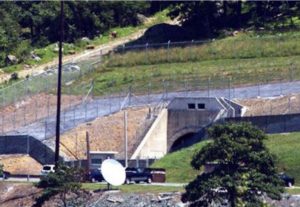 Known as Site R, Raven Rock Mountain Complex is a deep underground facility approved for construction by President Harry S Truman in 1950. The plan was for it to be a relocation site for the Pentagon in times of national emergency. To build the site, they workers had to blast out one half a million cubic yards of greenstone granite rock. The super-hard granite was secretly blasted out and hauled away over a period of ten months, to build five separate three-story buildings deep inside the mountain located along the border between Pennsylvania and Maryland, in Adams County, Pennsylvania. It operates under a number of…almost code names, Site R, AJCC: Alternate Joint Communications Center, ANMCC: Alternate National Military Command Center, NMCC-R: National Military Command Center – Raven Rock, USAG-RR: U.S. Army Garrison – Raven Rock, the Underground Pentagon, the Little Pentagon, the Backup Pentagon, the Rock, and for the old-timers: Harry’s Hole. All are interesting nicknames, for sure.
Known as Site R, Raven Rock Mountain Complex is a deep underground facility approved for construction by President Harry S Truman in 1950. The plan was for it to be a relocation site for the Pentagon in times of national emergency. To build the site, they workers had to blast out one half a million cubic yards of greenstone granite rock. The super-hard granite was secretly blasted out and hauled away over a period of ten months, to build five separate three-story buildings deep inside the mountain located along the border between Pennsylvania and Maryland, in Adams County, Pennsylvania. It operates under a number of…almost code names, Site R, AJCC: Alternate Joint Communications Center, ANMCC: Alternate National Military Command Center, NMCC-R: National Military Command Center – Raven Rock, USAG-RR: U.S. Army Garrison – Raven Rock, the Underground Pentagon, the Little Pentagon, the Backup Pentagon, the Rock, and for the old-timers: Harry’s Hole. All are interesting nicknames, for sure.
Once you are inside, you would not really know that you are underground, because, other than no outside  windows, the buildings look like any other office building. The underground complex has roads and perking areas that are big enough to accommodate trucks and buses. The facility is completely self-sufficient, boasting two power plants for electricity, multiple underground water reservoirs and a highly sophisticated ventilation system. It also has a medical and dental clinic, fire department, post office, dining facility, snack bar, dormitories, chapel, barbershop, fitness center, bowling alley, and even a Starbucks. It can accommodate 3,000 people in the event of an emergency, and can operate for at least 30 days in a “buttoned-up” position. Basically the facility is a small city.
windows, the buildings look like any other office building. The underground complex has roads and perking areas that are big enough to accommodate trucks and buses. The facility is completely self-sufficient, boasting two power plants for electricity, multiple underground water reservoirs and a highly sophisticated ventilation system. It also has a medical and dental clinic, fire department, post office, dining facility, snack bar, dormitories, chapel, barbershop, fitness center, bowling alley, and even a Starbucks. It can accommodate 3,000 people in the event of an emergency, and can operate for at least 30 days in a “buttoned-up” position. Basically the facility is a small city.
In the event of a war situation, the United States must be able to have a Continuity of Operations Plan (COOP) for the Office of the Secretary of Defense and the Joint Staff…basically a blueprint for how the government would re-position itself, if a major catastrophe strikes. Should the country find itself in such peril Senior leaders would be flown in by helicopter from the Pentagon and DOD emergency relocation teams all participate in real-life scenarios which test the alert and notification procedures along with the reception, staging, onward  movement, and integration (RSOI) procedures. These include the COOP transportation plans, Site R hasty access procedures, and the integration of mission essential functions within the operating routine of the alternate site, the backup Pentagon. Defense communications and planning would allegedly be handled at the Raven Rock Mountain Complex, but the structure of such a strategy has been hotly debated. Some sites on the internet had posted a “virtual tour” of Site R, but it is not the real site, other than possibly the pictures of the original work being done. Sites like this, that have national security as their top priority, are not something that is usually open to the public for viewing.
movement, and integration (RSOI) procedures. These include the COOP transportation plans, Site R hasty access procedures, and the integration of mission essential functions within the operating routine of the alternate site, the backup Pentagon. Defense communications and planning would allegedly be handled at the Raven Rock Mountain Complex, but the structure of such a strategy has been hotly debated. Some sites on the internet had posted a “virtual tour” of Site R, but it is not the real site, other than possibly the pictures of the original work being done. Sites like this, that have national security as their top priority, are not something that is usually open to the public for viewing.
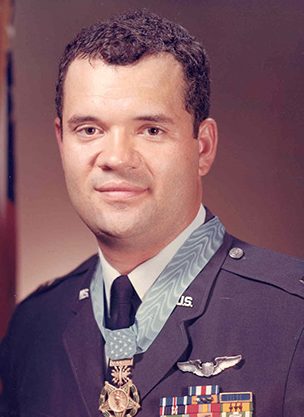 Our instincts tell us not to leave a man down, or behind. That doesn’t just apply just to military personnel. Nevertheless, military personnel have had that concept ingrained into their being…probably more so than the rest of us. It is a code for them…never leave a man behind…whenever they have any say about it, they don’t. 1st Lieutenant James P Fleming was no different. In fact, Fleming was exceptional. Fleming was a helicopter pilot during the Vietnam War. On November 26, 1968, Fleming and four other UH-1F helicopter pilots were returning to their base at Duc Co, South Vietnam, for refueling and rearming when an emergency call for help was received from a Special Forces reconnaissance team.
Our instincts tell us not to leave a man down, or behind. That doesn’t just apply just to military personnel. Nevertheless, military personnel have had that concept ingrained into their being…probably more so than the rest of us. It is a code for them…never leave a man behind…whenever they have any say about it, they don’t. 1st Lieutenant James P Fleming was no different. In fact, Fleming was exceptional. Fleming was a helicopter pilot during the Vietnam War. On November 26, 1968, Fleming and four other UH-1F helicopter pilots were returning to their base at Duc Co, South Vietnam, for refueling and rearming when an emergency call for help was received from a Special Forces reconnaissance team.
While en route, they got a call that a six-man Special Forces team was pinned down by a large, hostile force not far from a river bank. The homebound force of two gunships and three transport helicopters immediately changed course and sped to the area without refueling. As the gunships descended to attack the enemy positions, one was hit and downed. The remaining gunship made several passes, rapidly firing with its miniguns, but the intense  return fire from enemy machine guns continued. Finally, low on fuel, the helicopters were being forced to leave and return to base.
return fire from enemy machine guns continued. Finally, low on fuel, the helicopters were being forced to leave and return to base.
Lieutenant Fleming alone remained as the only transport helicopter left. He descended over the river to evacuate the team. Upon arrival, he found the area unsafe for landing because of the dense foliage, so he hovered just above the river with his landing skids braced against the bank. The lone gunship continued its strafing runs, but heavy enemy fire prevented the team from reaching the helicopter. Fleming’s leader advised him to withdraw. After pulling away, Lieutenant Fleming decided to make another rescue attempt before completely exhausting his fuel. He dropped down to the same spot and found that the team had managed to move closer to the river bank. The men dashed out and clambered aboard as bullets pierced the air, some 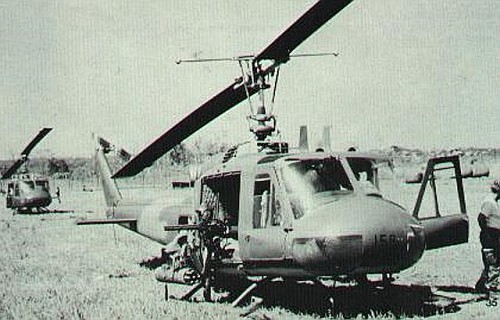 smashing into the helicopter. The rescue craft and the gunship then returned to Duc Co where it was discovered that they were nearly out of fuel.
smashing into the helicopter. The rescue craft and the gunship then returned to Duc Co where it was discovered that they were nearly out of fuel.
It was truly a miraculous rescue, in which not a single life was lost. Lieutenant Fleming was awarded the Medal of Honor for saving the lives of the special forces team that day. For his actions, Fleming received the Medal of Honor in May, 1970. Fleming remained in the Air Force serving a total of 30 years, becoming a colonel and a member of the Officer Training School staff at Lackland Air Force Base, Texas, before his retirement in 1996 at the rank of Colonel.
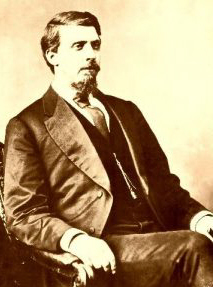 The Indian Territory, which is now Oklahoma, in 1875, was populated by cattle and horse thieves, whiskey peddlers, and bandits who sought refuge in the untamed territory that was free of a “White Man’s Court.” There was one court with jurisdiction over Indian Territory was the U.S. Court for the Western District of Arkansas located in Fort Smith, Arkansas, which was situated on the border of Western Arkansas and Indian Territory. Judge Isaac Parker, who was often called the “Hanging Judge,” from Fort Smith, Arkansas ruled over the lawless land of Indian Territory in the late 1800s. He was determined to stop the pollution of the Indian Territory that was the outlaws who thought they could outrun the law.
The Indian Territory, which is now Oklahoma, in 1875, was populated by cattle and horse thieves, whiskey peddlers, and bandits who sought refuge in the untamed territory that was free of a “White Man’s Court.” There was one court with jurisdiction over Indian Territory was the U.S. Court for the Western District of Arkansas located in Fort Smith, Arkansas, which was situated on the border of Western Arkansas and Indian Territory. Judge Isaac Parker, who was often called the “Hanging Judge,” from Fort Smith, Arkansas ruled over the lawless land of Indian Territory in the late 1800s. He was determined to stop the pollution of the Indian Territory that was the outlaws who thought they could outrun the law.
Judge Isaac Parker was born in a log cabin outside Barnesville, Belmont County, Ohio on October 15, 1838. The youngest son of Joseph and Jane Parker. As a boy, Isaac helped out on the farm, but never really cared for that type of work. He attended the Breeze hill primary school and then the Barnesville Classical Institute. Knowing he wanted more, he decided to go for a higher education. To help pay for it, he taught students in a country primary school. When he was 17 he decided to study law, his legal training consisting of a combination of apprenticeship and self study. Reading law with a Barnesville attorney, he passed the Ohio bar exam in 1859 at the age of 21. During this period of his life, he met and married Mary O’Toole and the couple had two sons, Charles and James. Over the years, Parker built a reputation for being an honest lawyer and a much respected leader of the community.
After Parker passed the bar, he decided to head west, ending up in Saint Joseph, Missouri a bustling Missouri River port town. He went to work for his uncle, D.E. Shannon, becoming a partner in the Shannon and Branch legal firm. By 1861, he was working on his own in both the municipal and county criminal courts. In April of 1861, he won the election as City Attorney. He was re-elected to the post for the next two years. In 1864, 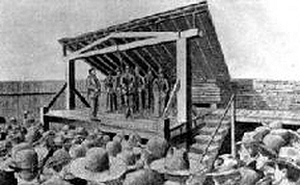 Isaac Parker ran for county prosecutor of the Ninth Missouri Judicial District and in the fall of that same year, he served as a member of the Electoral College, casting his vote for Abraham Lincoln. During a political career that included a six-year term as judge of the Twelfth Missouri Circuit in 1868, Parker would soon gain the experience that he would later use as the ruling Judge over the Indian Territory.
Isaac Parker ran for county prosecutor of the Ninth Missouri Judicial District and in the fall of that same year, he served as a member of the Electoral College, casting his vote for Abraham Lincoln. During a political career that included a six-year term as judge of the Twelfth Missouri Circuit in 1868, Parker would soon gain the experience that he would later use as the ruling Judge over the Indian Territory.
After the Civil War, the number of outlaws had grown, wrecking the relative peace of the five civilized tribes that lived in Indian Territory. By the time Parker arrived at Fort Smith, the Indian Territory had become known as a very bad place, where outlaws thought the laws did not apply to them and terror reigned. Parker replaced Judge William Story, whose tenure had been marred by corruption, after arriving in Fort Smith on May 4, 1875. At the age of 36, Judge Parker was the youngest Federal judge in the West. Holding court for the first time on May 10, 1875, eight men were found guilty of murder and sentenced to death. Judge Parker held court six days a week, often up to ten hours each day and tried 91 defendants in his first eight weeks on the bench. He was determined to clean up the Indian Territory, single handedly if necessary. In that first summer, eighteen persons came before him charged with murder and 15 were convicted. Eight of them were sentenced to die on the gallows on September 3, 1875. However, only six would be executed as one was killed trying to escape and a second had his sentence commuted to life in prison because of his young age.
The day of the September 3, 1875 hanging was a media circus, and because of all the attention, everyone knew that the once corrupt court was functioning properly again. Parker’s critics dubbed him the “Hanging Judge” and called his court the “Court of the Damned.” They thought Judge Parker was too harsh. The Fort 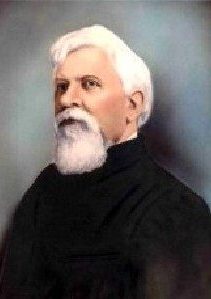 Smith Independent was the first newspaper to report the event on September 3, 1875 with the large column heading reading: “Execution Day!!” Other newspapers around the country reported the event a day later. These press reports shocked people throughout the nation. “Cool Destruction of Six Human Lives by Legal Process” screamed the headlines. Of the six felons, three were white, two were Native American and one was black. When the preliminaries were over, the six were lined up on the scaffold while executioner George Maledon adjusted the nooses around their necks. The trap was sprung all six died at once at the end of the ropes. The event solidified Judge Parker’s nickname for all time. In 21 years on the bench, Judge Parker tried 13,490 cases, 344 of which were capital crimes. 9,454 cases resulted in guilty pleas or convictions. Over the years, Judge Parker sentenced 160 men to death by hanging, though only 79 of them were actually hanged. The rest died in jail, appealed or were pardoned. Judge Parker died on November 17, 1896.
Smith Independent was the first newspaper to report the event on September 3, 1875 with the large column heading reading: “Execution Day!!” Other newspapers around the country reported the event a day later. These press reports shocked people throughout the nation. “Cool Destruction of Six Human Lives by Legal Process” screamed the headlines. Of the six felons, three were white, two were Native American and one was black. When the preliminaries were over, the six were lined up on the scaffold while executioner George Maledon adjusted the nooses around their necks. The trap was sprung all six died at once at the end of the ropes. The event solidified Judge Parker’s nickname for all time. In 21 years on the bench, Judge Parker tried 13,490 cases, 344 of which were capital crimes. 9,454 cases resulted in guilty pleas or convictions. Over the years, Judge Parker sentenced 160 men to death by hanging, though only 79 of them were actually hanged. The rest died in jail, appealed or were pardoned. Judge Parker died on November 17, 1896.
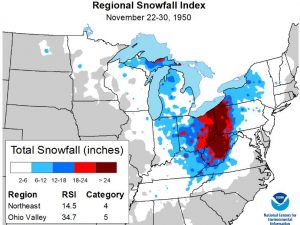
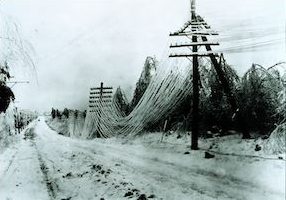 As winter arrived in Coburn Creek, West Virginia in 1950, a storm of epic proportions was about to set some serious records. From November 22 to 30, a slow-moving, powerful storm system dumped heavy snow across much of the central Appalachians. The storm would be remembered as as “The Great Appalachian Storm of 1950,” and it blanketed areas from western Pennsylvania southward deep into West Virginia with over 30 inches of snow. Several locations even received more than 50 inches of snow. Coburn Creek, West Virginia, reported the greatest snowfall total…a staggering 62 inches. Most towns can be shut own with 24 inches, so 62 inches was unthinkable. There is no way a car can get through that, in fact it will take hours to get a snowplow through it. For all intents and purposes, much of the Appalachian Mountains, and especially the Coburn Creek area were at a standstill.
As winter arrived in Coburn Creek, West Virginia in 1950, a storm of epic proportions was about to set some serious records. From November 22 to 30, a slow-moving, powerful storm system dumped heavy snow across much of the central Appalachians. The storm would be remembered as as “The Great Appalachian Storm of 1950,” and it blanketed areas from western Pennsylvania southward deep into West Virginia with over 30 inches of snow. Several locations even received more than 50 inches of snow. Coburn Creek, West Virginia, reported the greatest snowfall total…a staggering 62 inches. Most towns can be shut own with 24 inches, so 62 inches was unthinkable. There is no way a car can get through that, in fact it will take hours to get a snowplow through it. For all intents and purposes, much of the Appalachian Mountains, and especially the Coburn Creek area were at a standstill.
The cold front was massive, with frigid air stretching from the Northeast into the Ohio Valley and all the way down into the far Southeast. Temperatures fell to 22°F in Pensacola, Florida, 5°F in Birmingham, Alabama, 3°F in Atlanta, Georgia, and 1°F in Asheville, North Carolina. This record cold led to widespread crop damage, particularly in Georgia and South Carolina. In the north, intense winds associated with the storm caused extensive tree damage, power outages, and coastal flooding in New England. In New Hampshire, Mount Washington observed gusts as high as 160 mph. And, onshore winds along the coast caused extreme high tides and flooding in New Jersey and Connecticut. The storm was fairly short lived, and the temperatures quickly returned to normal in the first week of December 1950, bringing a whole new problem with them. The rise in temperatures led to a fast snowmelt, flooding several tributaries and major rivers. The Ohio River reached 28.5 feet, 4 feet above flood stage, in Pittsburgh. In Cincinnati, it reached 56 feet, also 4 feet above flood stage.
At the time, the Great Appalachian Storm of 1950 was one of the costliest storms on record, and it contributed to at least 160 deaths. Overall, on the Regional Snowfall Index (RSI) this powerful storm ranked as a Category 5…the worst category, for the Ohio Valley, and a Category 4 for the Northeast of the 212 storms our scientists have analyzed for the region. The RSI value of 34.7 securely locks its first place rank, well above the 24.6 RSI value second worst storm in March 1993. Only four Category 5 storms have impacted the Ohio Valley since 1900, so it is highly uncommon. During the storm, Pittsburgh, Pennsylvania, received 30.2 inches of snow, and both Erie, Pennsylvania, and Youngstown, Ohio, received more than 28 inches of snow. Across the region, over 18 inches of snow affected more than 6.1 million people. Such high snowfall totals affecting so many people largely contributed to the storm’s high ranking on the RSI scale.
In the Northeast region, the Great Appalachian Storm ranks as the ninth worst storm to impact the area out of the 203 analyzed. That fact seems surprising given the severity of the storm. I would have expected a much higher ranking. Over 30 inches of snow affecting 1.3 million people in the region largely contributed to the regional RSI value of 14.5. With that value, it ranks just behind the more recent February 2003, February 2010, and January 2016 storms. The late February snowstorm of 1969 remains the strongest storm to hit the 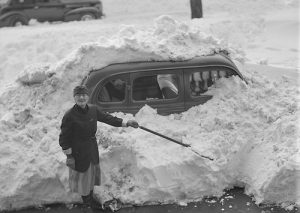
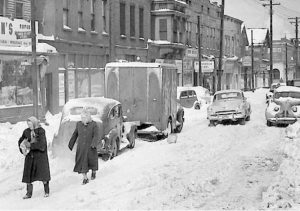 Northeast, with an RSI value of 34.0 making it a Category 5 or “Extreme” event. The March 1993 “Storm of the Century” remains the second strongest snowstorm to hit the Northeast, with an RSI value of 22.1 also making it a Category 5 event. As I look out my window at the light snow falling, I find myself feeling grateful that this storm is not expected to be anything like the Great Appalachian Storm of 1950.
Northeast, with an RSI value of 34.0 making it a Category 5 or “Extreme” event. The March 1993 “Storm of the Century” remains the second strongest snowstorm to hit the Northeast, with an RSI value of 22.1 also making it a Category 5 event. As I look out my window at the light snow falling, I find myself feeling grateful that this storm is not expected to be anything like the Great Appalachian Storm of 1950.
 For a number of years, my husband, Bob and I have dragged ourselves out of bed to jump into the Black Friday shopping,to get a head start on our Christmas shopping. Our morning started with a stop for much needed coffee, and a quick look at the ads to see where to start our shopping. While a lot of people have told us that we are crazy to enjoy this tradition, we really enjoyed it…until the stores changed it. Call me a traditionalist, but i don’t like the idea of shopping on Thanksgiving. That is a day to spend with family, and I see no sense in having the stores open at all. The people who are forced to work to keep the stores open, should be spending that time with their families, but instead they are working and I will not go out and shop when it means that those people are not able to spend Thanksgiving with their families, and that isn’t fair to them or their families.
For a number of years, my husband, Bob and I have dragged ourselves out of bed to jump into the Black Friday shopping,to get a head start on our Christmas shopping. Our morning started with a stop for much needed coffee, and a quick look at the ads to see where to start our shopping. While a lot of people have told us that we are crazy to enjoy this tradition, we really enjoyed it…until the stores changed it. Call me a traditionalist, but i don’t like the idea of shopping on Thanksgiving. That is a day to spend with family, and I see no sense in having the stores open at all. The people who are forced to work to keep the stores open, should be spending that time with their families, but instead they are working and I will not go out and shop when it means that those people are not able to spend Thanksgiving with their families, and that isn’t fair to them or their families.

When the stores started their “Black Friday” sales on Thanksgiving Day, it also eliminated the need to get up early on Friday to stand out in the cold and wait for the opening of the store, so you could try to be the first one to get in and get those “must have” gifts, that were on sale, starting at 6:00 in the morning. With the sale starting on Thursday, I would rather use the day to sleep in, and…maybe go shopping later in the day. I guess that we have just become disenchanted by the whole “Black Friday” event, because it starts on Thursday…and even on Wednesday in some stores, so that basically we are seeing the death of Black Friday. These days there are no crowds, even at the “Early Bird Sale.” If no one is rushing into the stores to buy, why should I get up at 4:00 in the morning to get there first?
Strangely, it seems like the sale items aren’t even that spectacular. I suppose there might be a few items that  are must haves, but nobody seems to be rushing out to buy those, and the stores seem to have more than enough of them to go around. Suddenly, black Friday shopping is just like any other day, except that I refuse to go shopping on Thanksgiving, because that is just wrong. I’m sure there are those out there who do shop on Thanksgiving, but I have too many family members who have had to work on thanksgiving because the store they work in is pen that day. They missed out on that time with their families, because the stores thought it would bring in a few dollars more. To those stores I say…no thanks, I’ll wait until Friday, or better yet…shop online!! I won’t be part of the complete disregard, by the stores, of the need for their employees to have family time.
are must haves, but nobody seems to be rushing out to buy those, and the stores seem to have more than enough of them to go around. Suddenly, black Friday shopping is just like any other day, except that I refuse to go shopping on Thanksgiving, because that is just wrong. I’m sure there are those out there who do shop on Thanksgiving, but I have too many family members who have had to work on thanksgiving because the store they work in is pen that day. They missed out on that time with their families, because the stores thought it would bring in a few dollars more. To those stores I say…no thanks, I’ll wait until Friday, or better yet…shop online!! I won’t be part of the complete disregard, by the stores, of the need for their employees to have family time.
 As we all know, Thanksgiving is a day to give thanks to God for the many blessing we have had throughout the year. Most of the time, we tend to be thankful for the same things…family, friends, jobs, a home…just to name a few. Like most people, I am thankful for those things too, but this year Thanksgiving has taken on a different meaning for me. Along with the normal things to be thankful for, I am so thankful that I am not a widow. That could have easily been the case, but God gave me and my family a miracle just a little over a month ago. That miracle was that while my husband, Bob Schulenberg could have died of a “Widowmaker” heart attack, he did not…nor is he incapacitated in any way.
As we all know, Thanksgiving is a day to give thanks to God for the many blessing we have had throughout the year. Most of the time, we tend to be thankful for the same things…family, friends, jobs, a home…just to name a few. Like most people, I am thankful for those things too, but this year Thanksgiving has taken on a different meaning for me. Along with the normal things to be thankful for, I am so thankful that I am not a widow. That could have easily been the case, but God gave me and my family a miracle just a little over a month ago. That miracle was that while my husband, Bob Schulenberg could have died of a “Widowmaker” heart attack, he did not…nor is he incapacitated in any way.
Bob’s miracle took the form of a number of Heaven sent people, who were in the exactly right place and the exactly right time to see Bob fall, come to his aid, perform CPR, and to add their prayers to mine, in our moment of urgency. Some of these people are really never at Walmart, where Bob fell in the parking lot, and yet God had orchestrated their unusual visit to happen at exactly the time it was need to save a life…my husband’s life. I have always known that God is on my side, but never was that fact made more clear to me than that Sunday afternoon. I had no idea what that shopping trip was going to end like. I had no idea that my faith, and the faith of so many other people was going to be called to action that day. There were  no real warning signs…or at least not that we took as warning signs. Bob was a healthy man, with none of the normal risk factors for heart disease. we had just come from a walk at the mall and he had bowled 6 games in a tournament the day before…and took first place in singles. Nevertheless, right after we got our groceries, a clot lodged in his Left Anterior Descending Artery…the Widowmaker kind of incident, and down he went.
no real warning signs…or at least not that we took as warning signs. Bob was a healthy man, with none of the normal risk factors for heart disease. we had just come from a walk at the mall and he had bowled 6 games in a tournament the day before…and took first place in singles. Nevertheless, right after we got our groceries, a clot lodged in his Left Anterior Descending Artery…the Widowmaker kind of incident, and down he went.
While I should have been in a state of panic, oddly I was not. Yes, I felt worry over him, but everything happened so fast that there was no time to panic. There was work to be done,and Ginger Sims, a progressive care nurse at Wyoming Medical Center, stepped in just about a minute after the heart attack started, and took control of the situation. Her “take charge” mannerisms, took the fear out of the situation, and put the action into it. With the help of her friend, WMC surgical nurse, Valya Boycheva, and WMC transport worker, Laura Lance, CPR was administered immediately, and the blood flow in bob’s body was maintained throughout the entire event. Because God spoke to these people and put them at Walmart that day, Bob had an excellent outcome to what could have been a life ending event.

After something like that, how can I possibly ever look at Thanksgiving in the same casual way I had before? The answer is that I can’t. God gave me a gift that is so amazing that I still have trouble wrapping my head around the events of that day, and just how blessed I am to still have my husband. There really is no way to totally make sense of it all, because it is bigger than the human mind can grasp. God is so good, and when he performs a miracle, it’s spectacular!! God doesn’t do things in a small way. He goes all out, and that is what he did for Bob. I can never thank God enough!! It’s been a whirlwind of activity, but much to be thankful for. Happy Thanksgiving everyone!!

